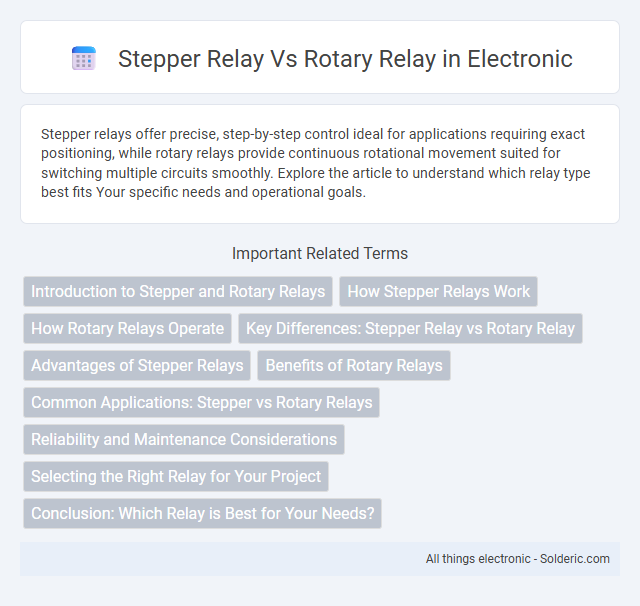Stepper relays offer precise, step-by-step control ideal for applications requiring exact positioning, while rotary relays provide continuous rotational movement suited for switching multiple circuits smoothly. Explore the article to understand which relay type best fits Your specific needs and operational goals.
Comparison Table
| Feature | Stepper Relay | Rotary Relay |
|---|---|---|
| Operation | Incremental step movement for position control | Continuous rotary motion for switching circuits |
| Applications | Precision control, sequencing, automation systems | Switching multiple circuits, telephone exchanges |
| Construction | Multiple contacts moved by electromagnetic steps | Rotating armature with multiple contacts |
| Control Method | Pulsed input signals for discrete steps | Continuous input voltage for rotation |
| Speed | Slower, stepwise movement | Faster continuous rotation |
| Usage Complexity | Requires discrete pulse control circuits | Simple voltage control |
| Reliability | High for precise positioning | High for rapid switching |
| Cost | Moderate to high due to complexity | Generally lower cost |
Introduction to Stepper and Rotary Relays
Stepper relays, designed for precise multi-position switching, utilize electromagnetic coils to incrementally move a rotor to distinct steps, offering reliable control for complex circuits. Rotary relays feature a continuously rotating armature, enabling smooth transition between contacts in applications requiring sequential switching or simple on/off functions. Your choice between stepper and rotary relays depends on the required precision and the nature of the electrical control system.
How Stepper Relays Work
Stepper relays operate by advancing through a series of discrete steps, controlled by electrical pulses, allowing precise positioning and timing in automated systems. Unlike rotary relays, which continuously rotate, stepper relays move incrementally, enabling accurate control over switching sequences or mechanical actions. Your automation setup can benefit from the precise control and repeatability offered by stepper relays in applications requiring exact stepwise operations.
How Rotary Relays Operate
Rotary relays operate by using a rotating armature that moves to various contact points, enabling the relay to switch between multiple circuits. This mechanical rotation is driven by an electromagnetic coil, which creates a magnetic field that causes the armature to pivot. The precise positioning of the armature allows rotary relays to provide reliable, multi-position switching for applications requiring distinct electrical paths.
Key Differences: Stepper Relay vs Rotary Relay
Stepper relays use a sequence of magnetic pulses to move contacts incrementally, providing precise multi-position switching ideal for complex control systems, whereas rotary relays rotate a contact arm to various fixed positions through a single magnetic actuation, offering simpler, fewer-position switching. Stepper relays excel in applications requiring fine control and multiple stable states, while rotary relays are preferred for straightforward position selection or binary switching. Understanding these key differences helps you choose the optimal relay type for your circuit control needs.
Advantages of Stepper Relays
Stepper relays offer precise control by enabling discrete positioning with multiple stable states, making them ideal for applications requiring accurate switching sequences. They provide enhanced reliability through reduced mechanical wear compared to rotary relays, as their stepping mechanism involves fewer moving parts. Stepper relays also support higher switching speeds and greater endurance in industrial automation and telecommunication systems.
Benefits of Rotary Relays
Rotary relays offer precise control over multiple switching positions with smooth, continuous rotation, making them ideal for applications requiring variable signal routing or multi-step processes. Their compact design and higher durability enhance reliability and reduce maintenance compared to stepper relays, which rely on discrete stepping movements. The ability to achieve seamless transition between contacts improves noise reduction and operational efficiency in complex electrical systems.
Common Applications: Stepper vs Rotary Relays
Stepper relays are commonly used in applications requiring precise multi-position switching, such as automation systems, industrial control panels, and multi-circuit switching in telecommunication equipment. Rotary relays are typically found in telephony, signaling, and sequential control tasks where fewer distinct positions and faster response times are essential. Your choice between stepper and rotary relays depends on the complexity of control, with stepper relays suited for more intricate sequential operations and rotary relays ideal for simpler, rapid switching functions.
Reliability and Maintenance Considerations
Stepper relays offer higher reliability due to their simpler construction and fewer moving parts, which reduces wear and tear compared to rotary relays. Rotary relays, however, may require more frequent maintenance and inspection to ensure proper contact alignment and prevent mechanical failure. Your choice should weigh the lower maintenance demands of stepper relays against the operational needs specific to rotary relay applications.
Selecting the Right Relay for Your Project
Selecting the right relay for your project depends on the specific control needs and application requirements. Stepper relays offer precise, multi-position control ideal for complex signaling and automation tasks, while rotary relays provide simpler, continuous rotation control suited for basic switching functions. Evaluating factors such as switching speed, contact configuration, and load capacity ensures optimal performance and reliability in your design.
Conclusion: Which Relay is Best for Your Needs?
Stepper relays provide precise multi-position control ideal for applications requiring selective switching, while rotary relays offer simpler, rotational switching mechanisms suited for fewer positions and faster operation. Your choice depends on the complexity of control, speed requirements, and the number of switching positions needed in your system. Evaluating the specific operational demands will help determine if a stepper relay's accuracy or a rotary relay's efficiency best fits your needs.
Stepper Relay vs Rotary Relay Infographic

 solderic.com
solderic.com